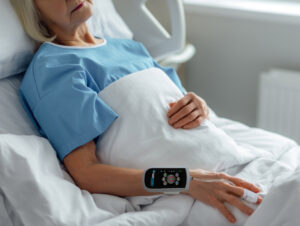
The Benefits Of Non-Invasive Blood Pressure Monitoring
In a hospital, blood pressure is typically measured in one of two ways. For patients in need of continuous blood pressure monitoring (eg in the ICU or operating theatre), intra-arterial monitoring is the standard practice, involving the insertion of a catheter into an artery and the patient’s blood pressure being displayed continuously on a pressure wave monitor.
For the patient’s journey beyond the ICU, however, such invasive blood pressure (IBP) monitoring becomes impractical, for several reasons. In this article, we will look at those reasons and how a wearable continuous blood pressure monitor can improve the situation for patients, clinicians and hospitals.
Risks associated with IBP
When a patient moves out of intensive care and onto the general ward, their blood pressure is monitored using a sphygmomanometer, or arm cuff – a device familiar to most patients from visiting their local doctor, as well as any hospital experiences. This non-invasive method is used in place of IBP for reasons of cost and patient comfort.
While IBP is the criterion standard for measuring blood pressure, providing the continuous accuracy and consistency required in critical care situations, it is not without its drawbacks. Cannulation of an artery must be carried out by a trained operator and can be time-consuming, as well as uncomfortable for the patient.
Furthermore, there is an associated risk (albeit small) of complications including hematoma, embolism, thrombosis, arterial damage, nerve damage, and infection. In very rare cases patients can develop ischemia, pseudo aneurysm or arteriovenous fistula.
Non-invasive blood pressure monitoring
While these complications are very rare, for the avoidance of any risk non-invasive blood pressure monitoring is used where patients are deemed to be non-critical.
Practicality and cost are further reasons. A sphygmomanometer is a relatively cheap piece of equipment compared with the apparatus required for IBP and it can be applied to a patient practically anywhere, without any great discomfort. Furthermore, any member of the nursing team will know how to apply it and take the necessary readings.
However, there are drawbacks to the arm cuff method too. Some patients do get anxious when they feel the cuff inflating on their upper arm, resulting in atypical measurements, known colloquially as ‘whitecoat syndrome’. Sphygmomanometer monitoring is not continuous either, typically taking place every four hours. That leaves long periods when a critical event like a fall in blood pressure can go unnoticed.
Various studies have shown that there is an increased risk of an acute hypotensive event in the days following surgery when patients have been returned to the general ward, and that the incidence of hypotension leading to cardiac arrest is particularly high. As a result, hospitals and clinicians are looking to wearable devices like Caretaker Medical’s VitalStream™, which provide continuous, non-invasive blood pressure monitoring (CNIBP).
The benefits of CNIBP
VitalStream™ is the world’s first wireless, wearable monitor for continuous blood pressure and advanced hemodynamics, having recently been granted FDA clearance for four new continuous hemodynamic parameters: cardiac output, stroke volume, heart rate variability, and left ventricular ejection time.
That means it combines the advantages of the two current standard methods of monitoring blood pressure – providing ICU level measurements continuously and non-invasively – with none of the drawbacks. Using a simple finger sensor connected to a wrist-mounted console, it can be fitted in under 30 seconds and remains with the patient wherever they go around the hospital, or even at home.
Because the measurements are continuous, it removes anomalies associated with whitecoat syndrome and picks up any significant change in blood pressure in real time, enabling doctors to respond to potentially severe events before they can develop.
Wireless connectivity integrates with electronic patient records, keeping a constant update on a patient’s condition. This makes it much quicker and easier for doctors to check on their patients wherever they are in the hospital, and know that they will be alerted immediately if any change is detected.
The future of patient monitoring
These benefits add up to a solution that is better for everyone in the patient continuum. For nurses, the speed and practicality of CNIBP makes it easier to carry out patient care without the hinderance of wires or the need to stop and take measurements. For doctors, the availability of real time patient information frees up time and increases the accuracy and promptness of their interventions.
For patients, the comfort and portability of a wearable non-invasive blood pressure monitor gives reassurance and a better level of care. And for hospitals, the increased efficiency means less cost and better patient outcome scores.
While wireless, continuous, non-invasive blood pressure monitoring may not yet be the standard, a growing body of eminent clinicians are convinced it will be before long.
More medical news and events

Caretaker Medical Receives Inaugural Healthcare Tech Innovation Award and $200,000 Grant from Medical Society of D.C.
WASHINGTON, DC, UNITED STATES, April 2, 2025 /EINPresswire.com/ -Caretaker Medical is honored to announce it has been awarded the Healthcare Technology Innovation Award, along with…

Caretaker Medical Awarded the Grand Prize in NIH RADx Tech for Maternal Health Challenge
Caretaker Medical, a digital health company focused on developing hemodynamic monitoring devices, today announced that it has been awarded the $525,000 grand prize in the…

VitalStream offers continuous hemodynamic monitoring solution amid IV fluid shortage
Philadelphia, PA – October 9, 2024 – Caretaker Medical, a pioneer in advanced hemodynamic monitoring technology, is highlighting the critical role of its VitalStream solution…
